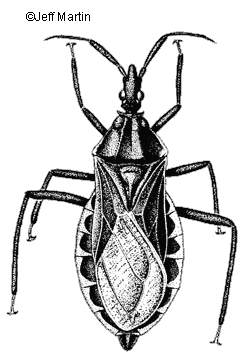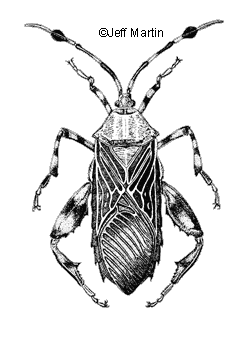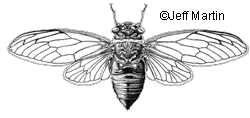Hemiptera & Homoptera
Many people refer to anything small that crawls on the ground as a “bug,” and indeed many insects have the word “bug”in their name, such as ladybug and lightningbug (both are actually beetles). The hemiptera, however, are the “true” bugs of the insect world, having distinct features that set them apart from other insect orders. Hemiptera means “halfwing,” in reference to the unique front pair of wings, which are leathery near their base and membranous towards the tips. Most species hold their wings flat over their backs with the two membranous portions overlapping. This combined with a triangular structure called a scutellum (located between the attachment sites of the two front wings) creates an x-shaped pattern on the back of many species. True bugs have slender, beak-like mouthparts that arise from the front of the head, and are usually folded along the ventral surface of the insect except when feeding. While most hemipterans suck the sap from plants, some are predatory, sucking the body fluids of other arthropods or even the blood of vertebrates. All hemipterans undergo incomplete metamorphosis with egg, nymph, and adult stages. Nymphs look very much like diminutive wingless adults.
 |
The Homoptera are close relatives of the Hemiptera and also have piercing-sucking mouthparts. In contrast to the Hemiptera, homopteran mouthparts arise further back on the underside of the head. Those forms that have wings have ones that are uniform in structure, hence their name, Homoptera, meaning “samewing.” Also unlike the Hemiptera, these insects hold their wings roof-like over their backs. All are plant feeders and most have incomplete metamorphosis. Many families within this order have very strange and complex life cycles with both sexual and asexual generations, winged and wingless generations, as well as individuals with much reduced, highly specialized structures.
Natural History
The Hemiptera and Homoptera are large orders of insects with too many species to cover in this book. Below are examples of a few of the more commonly encountered species.
Hemiptera
 |
Probably everyone’s least favorite representatives from this order are the conenose or kissing bugs. These blood-feeding insects in the family Reduviidae are a nuisance during the spring and summer months. We have several species (Triatoma rubida being the most common) whose primary hosts are the wood rat (Neotoma ssp.). They are most active at night during the months of May and June (a dispersal period). They occasionally venture into peoples’ homes, attracted by porch lights and finding entry through holes in window and door screens. Humans are usually bitten while they are sleeping and often don’t feel the actual bites. The next morning, however, victims awake with large, hard, itchy welts. Some unlucky people who have been bitten several times over an extended period become “sensitized”to these bites and actually develop a dangerous allergic reaction. As the insect feeds, it injects a small amount of saliva that contains both an anesthetic and an anticoagulant. It is usually one of these two components to which the victim’s immune system reacts. In Central and South America kissing bugs carry Chagas’ disease (a trypanosome). The bugs defecate while feeding; the victim later scratches the bite and thereby inadvertently rubs the trypanosome (located in the feces) into the wound. Although the species in the southwestern U.S. might be able to carry the desease, their feces are not yet known to contain the parasite, but in rural Sonora below 4500 feet (1500 m) Triatoma dimidiata does carry the disease. One of the more spectacular hemipteran representatives of our area is the giant mesquite bug (Thasus gigas). These beautiful insects can be found feeding on the fresh green stems and pods of mesquite during the early summer months. They are the largest of the true bugs in our area. Adults are brownish-black with orange-red bands on their legs and along the veins of their wings. Each of the two antennae has a round medallion-like segment. Nymphs are a gorgeous red and white and are usually found in clusters feeding together on the mesquite pods. When handled, these insects produce a potent, stinky secretion, but are otherwise harmless. Eggs look like small brown pillows glued in rows along the stems of the mesquite. Nymphs hatch from eggs in the spring, grow to become adults, mate, lay eggs, and then die by the end of summer, leaving new eggs to overwinter until the following spring.
Homoptera
Among the larger and more familiar representatives of this order are the cicadas. These musical insects are prevalent during the summer months and are usually first heard during the hot dry days of June before the monsoons. Most of us are probably familiar with the song, a loud buzzing noise emanating from a tree or shrub. Males sing to attract mates and can be very hard to locate since they usually stop singing as you approach their perch. An observant person is probably more familiar with the brown husks of exoskeleton left by nymphs when they emerge as adults. There are several species of cicadas in the Sonoran Desert region, with one of the most common species at lower elevations being the Apache cicada (Diceroprocta apache). Adults emerge in June, feed on plant sap, mate, and insert their eggs just under the surface of plant stems. These eggs hatch, and the larvae drop to the ground and dig into the soil to feed on the roots of various plants. In their underground homes, nymphs live and feed for 3 or more years before emerging as adults.
 |
The homopteran cochineal has a fascinating natural and cultural history. Cochineal belongs to the Coccoidea, or scale insects, a bizarre group of homopterans so specialized that they often do not look like insects at all. Cochineal, in the family Dactylopiidae, feed on cactus. You may have noticed a white moldy material growing on the prickly pear cacti in your yard or in the desert. Beneath the fluffy white mass reside the small cochineal insects. Females are dark red, wingless, legless, and sessile (attached to the plant and sedentary), and look like tiny grapes. The white material covering the insects is wax that females and nymphs secrete from special abdominal glands. Males are more insect-like and resemble small pink and white gnats, each with two long tails or caudal filaments. Males are most prevalent during the late summer when they emerge and mate. Once the females have mated, they lay eggs that hatch into tiny 6-legged nymphs called crawlers. These migrate to other pads on the cactus or crawl to a pad edge, secrete thin filaments of wax, and wait for the wind to pick them up and carry them to nearby cacti. Crawlers wander until they find suitable spots on cactus pads to settle, feed, and molt. As the tiny insects molt, they lose their legs and become sessile with only their mouthparts firmly tapped into the cactus.
Females, like most other homopterans, have incomplete metamorphosis, but males pupate within a tiny silken cocoon before emerging as adults.
Cochineals’ claim to fame is that their bodies contain a substance called carminic acid that produces a beautiful red dye. Native peoples from the Southwest, Mexico, and South America harvested these insects for the dye. Europeans discovered the dye when conquering the New World and the valuable product made many of them rich. Up to that time, most red dyes came from plant material. Cochineal, however, not only produced a superior red hue, but also withstood the effects of sun and washing much better than did the plant-derived dyes. Cochineal dye fell out of favor with the advent of synthetic dyes developed in the mid 1800s. However, it is making a comeback, as the more subtle hues of natural dyes are regaining popularity. It is also currently being used as a food and pharmaceutical dye, particularly since many of the synthetic food dyes have proven to be toxic. Look for cochineal or carmine on the labels of pink- and red-colored foods and medicines at the grocery store.
Other familiar homopterans are the aphids or plant lice. Most of us have encountered large groups of these little creatures feasting on the fleshy stems of herbaceous plants in the spring and summer. These tiny insects have very interesting and complex life cycles. Most species survive the winter as eggs and then hatch into females in the spring. These new females then begin to reproduce asexually on their host plants—which differ depending on the species of aphid—forming small colonies of clones. In many species, the colony eventually produces winged forms that fly off to a second host plant (sometimes a completely different plant species) and continue to reproduce. When fall approaches, winged forms migrate back to the original species of host plant and produce both males and females which mate and lay the overwintering eggs. An easy-to-recognize species that occurs in our area is the milkweed aphid, Aphis nerii. These beautiful aphids are bright yellow with black legs and antennae; they are found on various species of milkweed in the spring and summer months.










